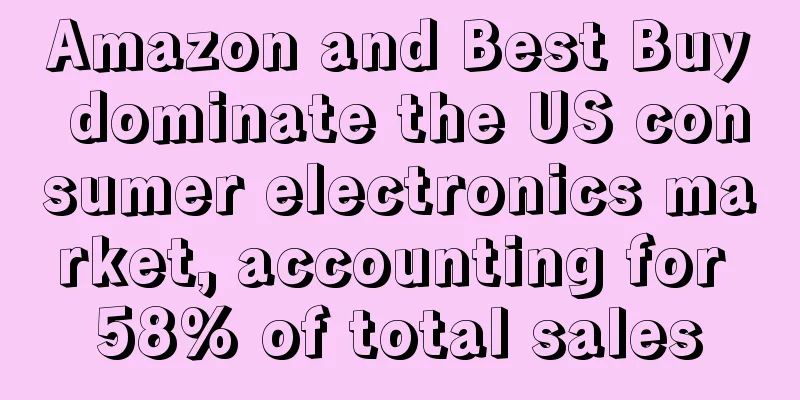Amazon and Best Buy dominate the US consumer electronics market, accounting for 58% of total sales

|
It is learned that according to foreign media reports, the latest data shows that Amazon and Best Buy dominate the US consumer electronics market, and Prime Day in July pushed Amazon's share soaring to 41%. According to the consumer electronics tracking report of market research firm Numerator, Best Buy and Amazon remained the two giants in the US consumer electronics market over the past year, accounting for 30% and 28% of total sales respectively, ahead of other major retailers such as Walmart, Costco, and Target. Image source: Numerator Amazon performed particularly well in the market in July, with its market share soaring to 41% due to its summer Prime Day promotion. In contrast, Best Buy's share fell from 32.2% in June to 26% during the same period, while Walmart's share also fell from 12.4% to 10.3%. This phenomenon shows that Amazon's major promotions have a significant short-term driving force in the consumer electronics market, causing an impact on competitors' sales. It is worth mentioning that although the overall penetration and purchase rate of consumer electronics in households has declined slightly, some categories still perform strongly. Data shows that computer monitors and peripherals are the only category that has increased in household penetration over the past year, reaching 37%. Meanwhile, purchases of smartwatches and fitness trackers grew fastest, up 17%. This reflects continued consumer demand in the areas of personal health and working from home. Consumers' price perception of electronic products also shows a certain rational trend. Nearly half of consumers (49.8%) believe that product prices are in line with their expectations, while 27.3% say the purchase price is lower than expected. In terms of purchasing channels, 37.8% of consumers learn about products by visiting stores, 27.3% obtain information through retailers’ websites, and 21.5% through recommendations from friends and relatives. Looking at the generational distribution of purchasers, Generation X and Millennials are the most active groups in purchasing electronics throughout the year, while Baby Boomers and older consumers are the least likely to purchase electronics. Although Generation Z is known for its technological susceptibility, its consumer electronics purchasing rate is lower than average, which may be related to its income level. In terms of full-year trends, the November and December holiday seasons are peak electronics purchases, followed by July, which includes Prime Day. Author ✎ Rayna/ Statement: This article is copyrighted and may not be reproduced without permission. If you need authorization, please contact: happy |
>>: Temu tops the US App Store annual downloads list! TikTok ranks third
Recommend
Walmart's online traffic is "declining", while offline traffic continues to grow
Walmart's daily website visits were down about...
What is ShopAtHome.com? ShopAtHome.com Review
ShopAtHome.com is a famous discount coupon website...
How do those new products manage to get dozens of orders a day without any coupons?
The update of Amazon platform rules has had a prof...
Etsy launches a new purchase protection program to protect buyers and sellers!
<span data-shimo-docs="[[20,"获悉,近日Etsy宣布,从...
65% of US SMBs expect e-commerce sales to grow by 2024
According to a 2024 e-commerce survey conducted by...
Are Amazon sellers still worried about reviews? Try Facebook chatbots
How to obtain reviews has always been a difficult...
Why is my PayPal account restricted?
When cross-border e-commerce sellers use PayPal, t...
What is Amazon India? Amazon India Store Review
Opening a store on Amazon India means registering ...
What is AMZ Insight? AMZ Insight Review
AMZ Insight can track the effects of the keywords ...
For Amazon boutique operations with a base salary of 30K, these are the operational skills you must understand and master!
1. Full picture of Amazon advertising knowledge 2...
My thoughts on off-site promotion
Many friends who have just started to do Amazon s...
What channels are available for purchasing Amazon's 1 million insurance?
Yesterday, I saw a message in my circle of friend...
Summary of hot search keywords on Amazon US in February! Seven potential categories have soared in popularity
It is learned that eCommerceNurse recently release...
Starting from scratch, Shopify sellers’ entrepreneurial stories series ③: Opening a store on Shopify and earning the first pot of gold
[Editor's Note] Sellers, do you want to know ...
What is China (Hangzhou) Cross-border E-commerce Comprehensive Pilot Zone? Evaluation of China (Hangzhou) Cross-border E-commerce Comprehensive Pilot Zone
China (Hangzhou) Comprehensive Pilot Zone for Cros...









